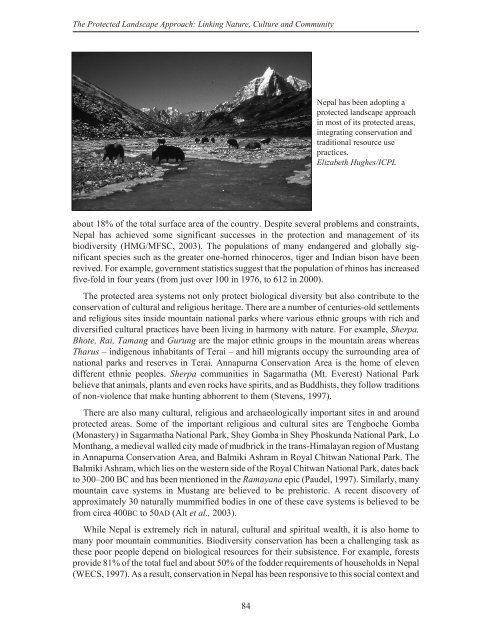The Protected Landscape Approach - Centre for Mediterranean ...
The Protected Landscape Approach - Centre for Mediterranean ...
The Protected Landscape Approach - Centre for Mediterranean ...
Create successful ePaper yourself
Turn your PDF publications into a flip-book with our unique Google optimized e-Paper software.
<strong>The</strong> <strong>Protected</strong> <strong>Landscape</strong> <strong>Approach</strong>: Linking Nature, Culture and Community<br />
Nepal has been adopting a<br />
protected landscape approach<br />
in most of its protected areas,<br />
integrating conservation and<br />
traditional resource use<br />
practices.<br />
Elizabeth Hughes/ICPL<br />
about 18% of the total surface area of the country. Despite several problems and constraints,<br />
Nepal has achieved some significant successes in the protection and management of its<br />
biodiversity (HMG/MFSC, 2003). <strong>The</strong> populations of many endangered and globally sig -<br />
nificant species such as the greater one-horned rhinoceros, tiger and Indian bison have been<br />
revived. For example, government statistics suggest that the population of rhinos has increased<br />
five-fold in four years (from just over 100 in 1976, to 612 in 2000).<br />
<strong>The</strong> protected area systems not only protect biological diversity but also contribute to the<br />
conservation of cultural and religious heritage. <strong>The</strong>re are a number of centuries-old settlements<br />
and religious sites inside mountain national parks where various ethnic groups with rich and<br />
diversified cultural practices have been living in harmony with nature. For example, Sherpa,<br />
Bhote, Rai, Tamang and Gurung are the major ethnic groups in the mountain areas whereas<br />
Tharus – indigenous inhabitants of Terai – and hill migrants occupy the surrounding area of<br />
national parks and reserves in Terai. Annapurna Conservation Area is the home of eleven<br />
different ethnic peoples. Sherpa communities in Sagarmatha (Mt. Everest) National Park<br />
believe that animals, plants and even rocks have spirits, and as Buddhists, they follow traditions<br />
of non-violence that make hunting abhorrent to them (Stevens, 1997).<br />
<strong>The</strong>re are also many cultural, religious and archaeologically important sites in and around<br />
protected areas. Some of the important religious and cultural sites are Tengboche Gomba<br />
(Monastery) in Sagarmatha National Park, Shey Gomba in Shey Phoskunda National Park, Lo<br />
Monthang, a medieval walled city made of mudbrick in the trans-Himalayan region of Mustang<br />
in Annapurna Conservation Area, and Balmiki Ashram in Royal Chitwan National Park. <strong>The</strong><br />
Balmiki Ashram, which lies on the western side of the Royal Chitwan National Park, dates back<br />
to 300–200 BC and has been mentioned in the Ramayana epic (Paudel, 1997). Similarly, many<br />
mountain cave systems in Mustang are believed to be prehistoric. A recent discovery of<br />
approximately 30 naturally mummified bodies in one of these cave systems is believed to be<br />
from circa 400BC to 50AD (Alt et al., 2003).<br />
While Nepal is extremely rich in natural, cultural and spiritual wealth, it is also home to<br />
many poor mountain communities. Biodiversity conservation has been a challenging task as<br />
these poor people depend on biological resources <strong>for</strong> their subsistence. For example, <strong>for</strong>ests<br />
provide 81% of the total fuel and about 50% of the fodder requirements of households in Nepal<br />
(WECS, 1997). As a result, conservation in Nepal has been responsive to this social context and<br />
84

















